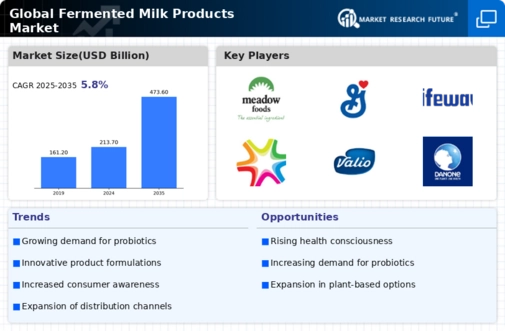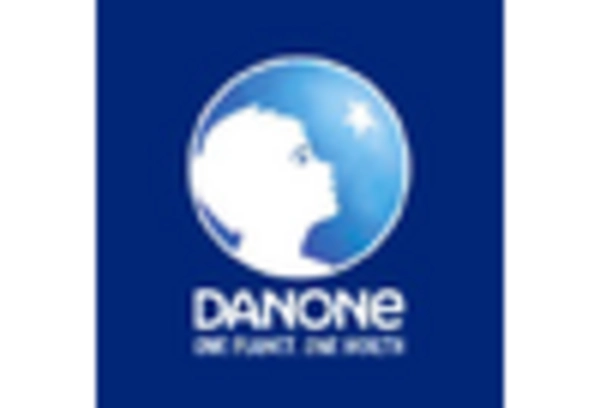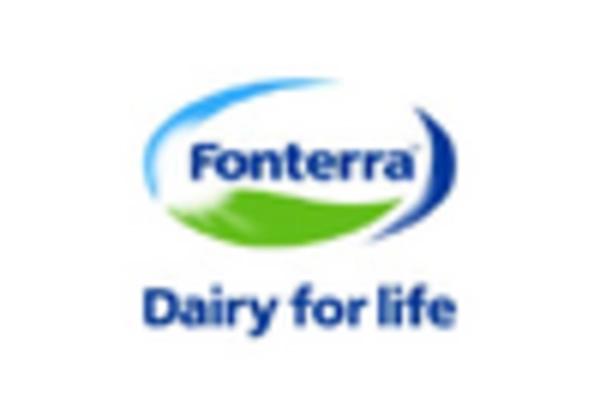-
EXECUTIVE SUMMARY
-
MARKET INTRODUCTION
-
Market Definition
-
Scope of the Study
- Research Objectives
- Assumptions & Limitations
-
Market Structure
-
MARKET RESEARCH METHODOLOGY
-
Research Process
-
Secondary Research
-
Primary Research
-
Forecast Model
-
MARKET LANDSCAPE
-
Supply Chain Analysis
- Raw Material Suppliers
- Manufacturers/Producers
- Distributors/Retailers/Wholesalers/E-Commerce
- End Users
-
Porter’s Five
- Bargaining Power of Suppliers
- Threat of Substitutes
- Internal Rivalry
-
Forces Analysis
-
Threat of New Entrants
-
Bargaining Power of Buyers
-
MARKET DYNAMICS OF GLOBAL FERMENTED MILK PRODUCTS
-
MARKET
-
Introduction
-
Drivers
-
Restraints
-
Opportunities
-
Challenges
-
GLOBAL FERMENTED MILK PRODUCTS MARKET, BY PRODUCT TYPE
-
Introduction
-
Yogurt
- Market Estimates & Forecast, 2024–2032
- Market Estimates
-
& Forecast, by Region, 2024–2032
-
Kefir
- Market Estimates & Forecast, 2024–2032
- Market Estimates
-
& Forecast, by Region, 2024–2032
-
Cheese
- Market Estimates & Forecast, 2024–2032
- Market Estimates
-
& Forecast, by Region, 2024–2032
-
Sour Cream
- Market Estimates & Forecast, 2024–2032
- Market Estimates
-
& Forecast, by Region, 2024–2032
-
Others
- Market Estimates & Forecast, 2024–2032
- Market Estimates
-
& Forecast, by Region, 2024–2032
-
GLOBAL FERMENTED MILK PRODUCTS MARKET, BY PACKAGING
-
TYPE
-
Introduction
-
Cartons
- Market Estimates
- Market Estimates & Forecast, by Region, 2024–2032
-
& Forecast, 2024–2032
-
Tubs
- Market Estimates &
- Market Estimates & Forecast, by Region, 2024–2032
-
Forecast, 2024–2032
-
Pouches
- Market Estimates
- Market Estimates & Forecast, by Region, 2024–2032
-
& Forecast, 2024–2032
-
Others
- Market Estimates
- Market Estimates & Forecast, by Region, 2024–2032
-
& Forecast, 2024–2032
-
GLOBAL FERMENTED MILK
-
PRODUCTS MARKET, BY DISTRIBUTION CHANNEL
-
Introduction
-
Store Based
- Market Estimates & Forecast, 2024–2032
- Market Estimates
- Hypermarkets & Supermarkerts
- Convenience Stores
- Others
-
& Forecast, by Region, 2024–2032
-
& Forecast, 2024–2032
-
& Forecast, 2024–2032
-
& Forecast, 2024–2032
-
Non-Store Based
- Market Estimates
- Market Estimates & Forecast, by Region, 2024–2032
-
& Forecast, 2024–2032
-
GLOBAL FERMENTED MILK
-
PRODUCTS MARKET, BY REGION
-
Introduction
-
North America
- Market Estimates & Forecast, 2024–2032
- Market Estimates &
- Market Estimates & Forecast, by Packaging
-
Forecast, by Product Type, 2024–2032
-
Type, 2024–2032
-
Market Estimates & Forecast, by Distribution Channel, 2024–2032
-
& Forecast, by Country, 2024–2032
-
Market Estimates
-
US
-
Market Estimates & Forecast, by Product Type,
-
Market Estimates & Forecast, by Packaging Type, 2024–2032
-
Forecast, by Distribution Channel, 2024–2032
-
Type, 2024–2032
-
Market Estimates &
-
Canada
-
Market Estimates & Forecast, by Product
-
Market Estimates & Forecast, by Packaging Type, 2024–2032
-
Forecast, by Distribution Channel, 2024–2032
-
Type, 2024–2032
-
Market Estimates &
-
Mexico
-
Market Estimates & Forecast, by Product
-
Market Estimates & Forecast, by Packaging Type, 2024–2032
-
Forecast, by Distribution Channel, 2024–2032
-
& Forecast, by Product Type, 2024–2032
-
Type, 2024–2032
-
Market Estimates &
-
Europe
- Market Estimates & Forecast, 2024–2032
- Market Estimates
- Market Estimates & Forecast, by Packaging
-
Market Estimates & Forecast, by Distribution Channel, 2024–2032
-
& Forecast, by Country, 2024–2032
-
Type, 2024–2032
-
Market Estimates
-
Germany
-
Market Estimates & Forecast, by Product
-
Market Estimates & Forecast, by Packaging Type, 2024–2032
-
Forecast, by Distribution Channel, 2024–2032
-
Market Estimates &
-
UK
-
Market Estimates & Forecast, by Product Type,
-
Market Estimates & Forecast, by Packaging Type, 2024–2032
-
Forecast, by Distribution Channel, 2024–2032
-
Type, 2024–2032
-
Market Estimates &
-
France
-
Market Estimates & Forecast, by Product
-
Market Estimates & Forecast, by Packaging Type, 2024–2032
-
Forecast, by Distribution Channel, 2024–2032
-
Type, 2024–2032
-
Market Estimates &
-
Spain
-
Market Estimates & Forecast, by Product
-
Market Estimates & Forecast, by Packaging Type, 2024–2032
-
Forecast, by Distribution Channel, 2024–2032
-
Type, 2024–2032
-
Market Estimates &
-
Italy
-
Market Estimates & Forecast, by Product
-
Market Estimates & Forecast, by Packaging Type, 2024–2032
-
Forecast, by Distribution Channel, 2024–2032
-
Type, 2024–2032
-
Market Estimates &
-
Rest of Europe
-
Market Estimates & Forecast, by Product
-
Market Estimates & Forecast, by Packaging Type, 2024–2032
-
Forecast, by Distribution Channel, 2024–2032
-
& Forecast, by Product Type, 2024–2032
-
Type, 2024–2032
-
Market Estimates &
-
Asia-Pacific
- Market Estimates & Forecast, 2024–2032
- Market Estimates
- Market Estimates & Forecast, by Packaging
-
Market Estimates & Forecast, by Distribution Channel, 2024–2032
-
& Forecast, by Country, 2024–2032
-
Type, 2024–2032
-
Market Estimates
-
China
-
Market Estimates & Forecast, by Product
-
Market Estimates & Forecast, by Packaging Type, 2024–2032
-
Forecast, by Distribution Channel, 2024–2032
-
Type, 2024–2032
-
Market Estimates &
-
Japan
-
Market Estimates & Forecast, by Product
-
Market Estimates & Forecast, by Packaging Type, 2024–2032
-
Forecast, by Distribution Channel, 2024–2032
-
Type, 2024–2032
-
Market Estimates &
-
India
-
Market Estimates & Forecast, by Product
-
Market Estimates & Forecast, by Packaging Type, 2024–2032
-
Forecast, by Distribution Channel, 2024–2032
-
Forecast, by Product Type, 2024–2032
-
Type, 2024–2032
-
Market Estimates &
-
Australia & New Zealand
-
Market Estimates &
-
Market Estimates & Forecast, by Packaging
-
Market Estimates & Forecast, by Distribution Channel, 2024–2032
-
& Forecast, by Product Type, 2024–2032
-
Type, 2024–2032
-
Rest of Asia-Pacific
-
Market Estimates
-
Market Estimates & Forecast, by Packaging
-
Market Estimates & Forecast, by Distribution Channel, 2024–2032
-
Rest of the World
- Market Estimates
- Market Estimates & Forecast, by Product Type, 2024–2032
- Market Estimates
- Market Estimates & Forecast, by Distribution
- Market Estimates & Forecast, by Country, 2024–2032
- South America
-
& Forecast, 2024–2032
-
& Forecast, by Packaging Type, 2024–2032
-
Channel, 2024–2032
-
& Forecast, by Product Type, 2024–2032
-
Type, 2024–2032
-
Market Estimates & Forecast, by Distribution Channel, 2024–2032
-
& Forecast, by Product Type, 2024–2032
-
Type, 2024–2032
-
Middle East
-
Market Estimates
-
Market Estimates & Forecast, by Packaging
-
Market Estimates & Forecast, by Distribution Channel, 2024–2032
-
& Forecast, by Product Type, 2024–2032
-
Type, 2024–2032
-
Africa
-
Market Estimates
-
Market Estimates & Forecast, by Packaging
-
Market Estimates & Forecast, by Distribution Channel, 2024–2032
-
COMPETITIVE LANDSCAPE
-
Introduction
-
Market Strategies
-
Key Development
-
Analysis
-
(Expansions/Mergers
-
& Acquisitions/Joint Ventures/New Product Developments/Agreements/Investments)
-
COMPANY PROFILES
-
Nestle S.A.
- Company Overview
- Financial Updates
- Product/Business
- Key Strategies
- Key Developments
- SWOT Analysis
-
Segment Overview
-
Key Strategies
-
Key Developments
-
SWOT Analysis
-
Danone
-
Company Overview
-
Financial Updates
-
Product/Business Segment Overview
-
Valio Ltd.
- Company Overview
- Financial Updates
- Product/Business Segment Overview
- Key Strategies
- Key Developments
- SWOT Analysis
-
FrieslandCampina
- Company Overview
- Financial Updates
- Product/Business
- Key Strategies
- Key Developments
- SWOT Analysis
-
Segment Overview
-
Key Strategies
-
Key Developments
-
SWOT Analysis
-
Danisco A/S
-
Company Overview
-
Financial Updates
-
Product/Business Segment Overview
-
Lifeway Foods, Inc.
- Company Overview
- Financial Updates
- Product/Business Segment Overview
- Key Strategies
- Key Developments
- SWOT Analysis
-
Bio-K Plus International
- Key Strategies
- Key Developments
- SWOT Analysis
-
Inc.
-
Company Overview
-
Financial Updates
-
Product/Business Segment Overview
-
General Mills, Inc.
- Company Overview
- Financial Updates
- Product/Business Segment Overview
- Key Strategies
- Key Developments
- SWOT Analysis
-
Morinaga Milk Industry
- Key Strategies
- Key Developments
- SWOT Analysis
-
Co., Ltd.
-
Company Overview
-
Financial Updates
-
Product/Business Segment Overview
-
Mother Dairy Fruit & Vegetable Pvt Ltd.
- Company Overview
- Financial Updates
- Product/Business
- Key Strategies
- Key Developments
- SWOT Analysis
-
Segment Overview
-
Key Strategies
-
Key Developments
-
SWOT Analysis
-
Meadow Foods Limited
-
Company Overview
-
Financial Updates
-
Product/Business Segment Overview
-
Dairy Manufacturers, Inc.
- Company Overview
- Financial Updates
- Product/Business
- Key Strategies
- Key Developments
- SWOT Analysis
-
Segment Overview
-
Key Strategies
-
Key Developments
-
SWOT Analysis
-
DSM NV
-
Company Overview
-
Financial Updates
-
Product/Business Segment Overview
-
Chr. Hansen Holding A/S
- Company Overview
- Financial Updates
- Product/Business
-
Segment Overview
-
Key Strategies
-
Key Developments
-
SWOT Analysis
-
CONCLUSION
-
LIST
-
OF TABLES
-
Table
-
Global Fermented Milk Products Market, by Region, 2024–2032 (USD Million)
-
Global Fermented
-
Milk Products Market, by Product Type, 2024–2032 (USD Million)
-
Global Fermented Milk
-
Products Market, by Packaging Type, 2024–2032 (USD Million)
-
Global Fermented Milk
-
Products Market, by Distribution Channel, 2024–2032 (USD Million)
-
North America:
-
Fermented Milk Products Market, by Country, 2024–2032 (USD Million)
-
North America:
-
Fermented Milk Products Market, by Product Type, 2024–2032 (USD Million)
-
North America:
-
Fermented Milk Products Market, by Packaging Type, 2024–2032 (USD Million)
-
North America:
-
Fermented Milk Products Market, by Distribution Channel, 2024–2032 (USD Million)
-
US: Fermented
-
Milk Products Market, by Product Type, 2024–2032 (USD Million)
-
US: Fermented Milk Products
-
Market, by Packaging Type, 2024–2032 (USD Million)
-
US: Fermented Milk Products Market, by Distribution
-
Channel, 2024–2032 (USD Million)
-
Canada: Fermented Milk Products Market, by Product
-
Type, 2024–2032 (USD Million)
-
Canada: Fermented Milk Products Market, by Packaging
-
Type, 2024–2032 (USD Million)
-
Canada: Fermented Milk Products Market, by Distribution
-
Channel, 2024–2032 (USD Million)
-
Mexico: Fermented Milk Products Market, by Product
-
Type, 2024–2032 (USD Million)
-
Mexico: Fermented Milk Products Market, by Packaging
-
Type, 2024–2032 (USD Million)
-
Mexico: Fermented Milk Products Market, by Distribution
-
Channel, 2024–2032 (USD Million)
-
Europe: Fermented Milk Products Market, by Country,
-
Europe: Fermented Milk Products Market, by Product Type, 2024–2032
-
(USD Million)
-
Table
-
Europe: Fermented Milk Products Market, by Packaging Type, 2024–2032 (USD
-
Million)
-
Table
-
Europe: Fermented Milk Products Market, by Distribution Channel, 2024–2032
-
(USD Million)
-
Table
-
Germany: Fermented Milk Products Market, by Product Type, 2024–2032 (USD
-
Million)
-
Table
-
Germany: Fermented Milk Products Market, by Packaging Type, 2024–2032 (USD
-
Million)
-
Table
-
Germany: Fermented Milk Products Market, by Distribution Channel, 2024–2032
-
(USD Million)
-
Table
-
France: Fermented Milk Products Market, by Product Type, 2024–2032 (USD
-
Million)
-
Table
-
France: Fermented Milk Products Market, by Packaging Type, 2024–2032 (USD
-
Million)
-
Table
-
France: Fermented Milk Products Market, by Distribution Channel, 2024–2032
-
(USD Million)
-
Table
-
Italy: Fermented Milk Products Market, by Product Type, 2024–2032 (USD
-
Million)
-
Table
-
Italy: Fermented Milk Products Market, by Packaging Type, 2024–2032 (USD
-
Million)
-
Table
-
Italy: Fermented Milk Products Market, by Distribution Channel, 2024–2032
-
(USD Million)
-
Table
-
Spain: Fermented Milk Products Market, by Product Type, 2024–2032 (USD
-
Million)
-
Table
-
Spain: Fermented Milk Products Market, by Packaging Type, 2024–2032 (USD
-
Million)
-
Table
-
Spain: Fermented Milk Products Market, by Distribution Channel, 2024–2032
-
(USD Million)
-
Table
-
UK: Fermented Milk Products Market, by Product Type, 2024–2032 (USD Million)
-
UK: Fermented
-
Milk Products Market, by Packaging Type, 2024–2032 (USD Million)
-
UK: Fermented
-
Milk Products Market, by Distribution Channel, 2024–2032 (USD Million)
-
Rest of Europe:
-
Fermented Milk Products Market, by Product Type, 2024–2032 (USD Million)
-
Rest of Europe:
-
Fermented Milk Products Market, by Packaging Type, 2024–2032 (USD Million)
-
Rest of Europe:
-
Fermented Milk Products Market, by Distribution Channel, 2024–2032 (USD Million)
-
Asia-Pacific:
-
Fermented Milk Products Market, by Country, 2024–2032 (USD Million)
-
Asia-Pacific:
-
Fermented Milk Products Market, by Product Type, 2024–2032 (USD Million)
-
Asia-Pacific:
-
Fermented Milk Products Market, by Packaging Type, 2024–2032 (USD Million)
-
Asia-Pacific:
-
Fermented Milk Products Market, by Distribution Channel, 2024–2032 (USD Million)
-
China: Fermented
-
Milk Products Market, by Product Type, 2024–2032 (USD Million)
-
China: Fermented Milk
-
Products Market, by Packaging Type, 2024–2032 (USD Million)
-
China: Fermented Milk
-
Products Market, by Distribution Channel, 2024–2032 (USD Million)
-
India: Fermented
-
Milk Products Market, by Product Type, 2024–2032 (USD Million)
-
India: Fermented Milk
-
Products Market, by Packaging Type, 2024–2032 (USD Million)
-
India: Fermented Milk
-
Products Market, by Distribution Channel, 2024–2032 (USD Million)
-
Japan: Fermented
-
Milk Products Market, by Product Type, 2024–2032 (USD Million)
-
Japan: Fermented Milk
-
Products Market, by Packaging Type, 2024–2032 (USD Million)
-
Japan: Fermented Milk
-
Products Market, by Distribution Channel, 2024–2032 (USD Million)
-
Rest of Asia-Pacific:
-
Fermented Milk Products Market, by Product Type, 2024–2032 (USD Million)
-
Rest of Asia-Pacific:
-
Fermented Milk Products Market, by Packaging Type, 2024–2032 (USD Million)
-
Rest of Asia-Pacific:
-
Fermented Milk Products Market, by Distribution Channel, 2024–2032 (USD Million)
-
Rest of the
-
World (RoW): Fermented Milk Products Market, by Country, 2024–2032 (USD Million)
-
Rest of the
-
World (RoW): Fermented Milk Products Market, by Product Type, 2024–2032 (USD
-
Million)
-
Table
-
Rest of the World (RoW): Fermented Milk Products Market, by Packaging Type, 2024–2032
-
(USD Million)
-
Table
-
Rest of the World (RoW): Fermented Milk Products Market, by Distribution Channel,
-
South America: Fermented Milk Products Market, by Product
-
Type, 2024–2032 (USD Million)
-
South America: Fermented Milk Products Market,
-
by Packaging Type, 2024–2032 (USD Million)
-
South America: Fermented Milk Products Market,
-
by Distribution Channel, 2024–2032 (USD Million)
-
Middle East: Fermented Milk Products Market,
-
by Product Type, 2024–2032 (USD Million)
-
Middle East: Fermented Milk Products Market,
-
by Packaging Type, 2024–2032 (USD Million)
-
Middle East: Fermented Milk Products Market,
-
by Distribution Channel, 2024–2032 (USD Million)
-
Africa: Fermented Milk Products Market,
-
by Product Type, 2024–2032 (USD Million)
-
Africa: Fermented Milk Products Market,
-
by Packaging Type, 2024–2032 (USD Million)
-
Africa: Fermented Milk Products Market,
-
by Distribution Channel, 2024–2032 (USD Million)
-
LIST OF FIGURES
-
Global Fermented Milk
-
Products Market Segmentation
-
Forecast Research Methodology
-
Five Forces Analysis of the Global Fermented
-
Milk Products Market
-
FIGURE
-
Value Chain of the Global Fermented Milk Products Market
-
Share of the Global Fermented Milk Products
-
Market in 2024, by Country (%)
-
Global Fermented Milk Products Market, by Region, 2024–2032,
-
Global Fermented
-
Milk Products Market Size, by Product Type, 2024
-
Share of the Global Fermented Milk Products
-
Market, by Product Type, 2024–2032 (%)
-
Global Fermented Milk Products Market Size,
-
by Packaging Type, 2024
-
Share of the Global Fermented Milk Products Market, by Packaging
-
Type, 2024–2032 (%)
-
Global Fermented Milk Products Market Size, by Distribution
-
Channel, 2024
-
FIGURE
-
Share of the Global Fermented Milk Products Market, by Distribution Channel,

















Leave a Comment